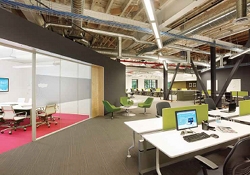by Robin Weckesser — The idea of alternative workplace strategies (AWS) is not new. But while companies have for some time tried to improve their workflow and reduce expenses, the process and implementation have changed dramatically. Today, thanks to advanced technology, a cultural shift and economic conditions that prompt downsizing, more tenants are addressing the physical requirements of their organizations — and in many cases they are seeking new workplace solutions.
For example, in the San Francisco Bay Area and Silicon Valley, which tend to be at the forefront of technology and lifestyle trends, more tenants are now planning for the workplace of tomorrow.
In San Francisco, younger generations of web and social/digital-media companies are demanding creative space alternatives. Throughout the area, startups as well as established companies are benchmarking against companies that have saved significantly while also improving their productivity and morale. Whether tenants are renovating existing space or relocating, they need to put these concepts to work, and they are often turning to experienced project managers to help them find customized, cost-cutting solutions.
In the Bay Area, Skype, GLOBALFOUNDRIES and Palo Alto Networks are recent examples of companies that have implemented different workplace strategies. This trend is expected to continue. Especially while it’s still a tenant’s market, space occupiers have an opportunity to exercise their leverage in negotiations with landlords. This includes pushing landlords to contribute to workplace solutions through tenant improvement allowances.
Indeed, we are witnessing a new wave of organizations that are striving to do more with less. This leads us to suggest a new term to describe this growing trend: Workplace Optimization Strategies (WOS). In short, WOS is a process that has produced very positive results when executed properly.
Drivers at Work
Let’s take a closer look at the forces behind the workplace optimization phenomenon:

Economy. Slow job growth, including high underemployment (part-time workers) continues to stall the recovery. Downsizing continues in many sectors, and this has led to reduced footprints in a majority of offices. In this environment, where budgetary constraint is still the mantra, there is typically a lack of “buzz” because of so much vacant space. And while it is challenging for companies to economize and innovate at the same time, we have seen companies accomplish both.
To illustrate the economic impact of WOS, consider that the old model of 300 square feet (27.9 square meters) per person is now generally 240 square feet (22.3 square meters) per person or less. Further, office utility increasingly is being measured in terms of ratios of desks per full- time employee (FTE) rather than square feet per FTE. In any event, the net effect of this kind of space reduction typically translates into substantial savings, usually at least 20 percent.
Technology. While the face of the traditional office started to change years ago, what have truly accelerated this transformation are the technological advancements that allow employees to work virtually at any time. Today, as bandwidth on wireless devices continues to increase, employees typically have at their fingertips all the information they need to be successful out of the office. At the same time, companies can more easily reduce their square footage — and enhance their bottom line. In the future, as video becomes more prevalent, virtual presence will deliver additional opportunities.
Culture. This is not your grandfather’s — or father’s — workplace. In many organizations, four generations are on the same payroll: Traditionalists (born before 1945), Boomers (born 1946-1964), Generation X (born 19651977) and Millennials (born 19781999). The challenge at work is to address the different styles, values and expectations and to find common denominators. Generation X and Millennials are much more comfortable with the digital world, multi-tasking and electronic communication that frequently preclude the need for faceto- face interaction. And as use of social media explodes, these generations will continue to drive evolving solutions.
New Systems at Work
Tied to these drivers, many companies have implemented new space plans with common characteristics.
Smaller workstations. While the overall footprint per employee is compressing, so is the size of workstations. Cubicles that have traditionally been 8 by 8 are now often 6 by 8. Though smaller, they are designed to be more efficient to encourage interaction and communication, while providing appropriate space for “heads-down” work. They are also relatively inexpensive to install because the price of furniture has come down.
The new cube. The traditional cubicle is evolving. As the footprint is shrinking, the walls of the personal bunker are coming down and giving way to space that supports team collaboration and interaction. Still, seated privacy allows for heads-down work and a place for personal items. And the answer to the old question about “Where will I put my family photos?” is to insert a flash drive into a digital picture frame.
Reconfiguration. To fill empty seats and the associated feeling of being disconnected, facility and project managers are consolidating and “restacking” staff in many locations. This brings employees closer together, and it also may allow companies to sublease the vacated areas, if lease terms permit.
Virtual offices. As stated earlier, the number of remote work settings is proliferating, thanks to broadband wireless for laptops, smart phones, iPads and virtual webinar meetings. Today’s office may be a den, coffee shop, cafeteria, train, mall, motel, etc. To promote virtual offices, more companies are offering staff laptops and smart phones as part of their employment packages — not so much because it is expected, but because it is needed to increase productivity.
Hotelling. While there’s still a need for a home office base and group meetings, the idea of one person per cube is yielding to shared space. With hotelling, also referred to as unassigned seating, employees typically use a central reservation system tied to the Intranet or phone system to arrange office slots, planning their schedules to best utilize time in the office and off site. Related to this are new mobile furniture solutions, such as file cabinets that allow workers to transport their belongings while they are on site.
Open spaces, common areas. Along with cubicle downsizing, tenants are also revitalizing their worksites through spaces that support formal and informal communication and interaction. Build-outs generally promote comfortable, collaborative work areas, soft seating and open environments with workstations that allow staff to view the entire area. Ultimately, the aim is to facilitate communication and create a more enjoyable place to work while improving the bottom line.
More companies are engaging in sustainable practices, which promote healthier worksites and don’t necessarily add expenses. Studies show that going green is another way to improve morale and give companies a competitive edge.
Other benefits of WOS include staff recruitment and retention along with better social networking. But bottom- line savings are cited by most companies as the number-one reason to implement new workplace solutions. For those companies that might question an initial investment in WOS, it’s hard to argue with increased overall productivity and faster time to market for products.
Boiled down, the workplace is now often viewed as a communication tool that supports a process; that process is product development.
Will It Work for You?
Of course, all new programs come with trade-offs and growing pains. This includes the reluctance of some senior managers who may still have entitlement issues despite the cultural trend toward workplace equality. They may also have concerns about managing remote staff that don’t have 9 to 5 accountability. It’s definitely a new paradigm, and new management skills may be required. Staff at all levels will need to adjust and strive toward new levels of trust. This should become easier as new workplace strategies become more mainstream and companies accept the need to focus on the common good.
How, then, should companies get started? First, they need to determine their true vacancy and, consequently, the true cost of occupancy. This will help evaluate what kinds of workplace solutions are right for them and what resources are necessary for implementation.
There are various staffing scenarios involving in house versus outsourced responsibilities and the roles of upfront strategic planning and project management implementation. While you will want to conduct your due diligence and review different options, we have found that an advantage of using outside, objective consultants is that it is easier to arrive at consensus.
In the final analysis, the success of this process depends on how well companies align their workplace strategies with their business plans and how well plans are executed. In any event, it may be time to look ahead as the office of the future takes shape today. So, consider what’s missing in your workplace, and plan to optimize it moving forward.

For more information on this topic, please visit CoreNet Global’s Knowledge Center Online.
Young Leaders: The Future of Workplace and How We See It
Generational Preferences as a Glimpse into the Future Workplace
Robin Weckesser is a Principal at CresaPartners in San Jose and is the Head of the office’s Project Management group.